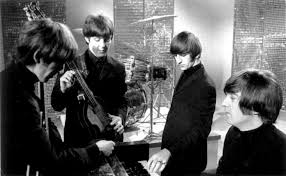People in US were listening to We Can Work It Out by The Beatles. In UK Day Tripper / We Can Work It Out by The Beatles was in the top 5 hits.
- Register
- Log in to Tune-In
- Wishlist (0)
-
Shopping cart
(0)
You have no items in your shopping cart.
Beatles A Day in the Life Blog posts of '1966' 'January'
Top Hits - 50 years ago today
1. The Sounds of Silence - Simon & Garfunkel (Columbia)
2. We Can Work It Out - The Beatles (Capitol)
3. As Tears Go By - The Rolling Stones (London)
4. You Didn't Have to Be So Nice - The Lovin' The Lovin' Spoonful
5. The Duck - Jackie Lee (Mirwood)
6. Turn! Turn! Turn! - The Byrds (Columbia)
7. She's Just My Style - Gary Lewis & the Playboys (Liberty)
8. The Men In My Little Girl's Life - Mike Douglas (Epic)
9. Flowers On the Wall - The Statler Brothers (Columbia)
10. A Must to Avoid - Herman's Hermits (MGM)
Brian Epstein is appointed a director of Lennon Books Limited, John Lennon’s book royalty collection company.
People in US were listening to We Can Work It Out by The Beatles. In UK Day Tripper / We Can Work It Out by The Beatles was in the top 5 hits.
We Can Work It Out becomes the #1 single in the US.
The Beatles' album Rubber Soul is #1 in the US. It remains at #1 for six weeks and stays on the charts for 56 weeks. Rubber Soul is the seventh Beatles LP to reach #1 in the US (the other six are Meet the Beatles, The Beatles Second Album, A Hard Day's Night, Beatles '65, Beatles VI, and Help!).
Also 50 years Ago - John Lennon, George Harrison, and Ringo Starr attend a party thrown by Mick Jagger at his London townhouse.
We Can Work It Out - Number One!
We Can Work It Out (Number One 50 years ago) Behind the song.......
McCartney wrote the words and music to the verses and the chorus, with lyrics that "might have been personal", probably a reference to his relationship with Jane Asher. McCartney then took the song to Lennon:
I took it to John to finish it off, and we wrote the middle together. Which is nice: 'Life is very short. There's no time for fussing and fighting, my friend.' Then it was George Harrison's idea to put the middle into 3/4 time, like a German waltz. That came on the session, it was one of the cases of the arrangement being done on the session.
With its intimations of mortality, Lennon's contribution to the twelve-bar bridge contrasts typically with what Lennon saw as McCartney's cajoling optimism,a contrast also seen in other collaborations by the pair, such as "Getting Better" and "I've Got a Feeling". As Lennon told "Playboy" in 1980:
In We Can Work It Out, Paul did the first half, I did the middle eight. But you've got Paul writing, 'We can work it out / We can work it out'—real optimistic, y'know, and me, impatient: 'Life is very short, and there's no time / For fussing and fighting, my friend.'
Based on those comments, some critics overemphasized McCartney's optimism, neglecting the toughness in passages written by McCartney,such as "Do I have to keep on talking until I can't go on?". Lennon's middle shifts focus from McCartney's concrete reality to a philosophical perspective in B minor, illustrating this with the waltz-time section suggested by George Harrison that leads back to the verse,possibly meant to suggest tiresome struggle.
Following their record breaking concert at New York's Shea Stadium on August 15, 1965, it was decided that extra recordings would be needed if the footage was to be released to the public.
The concert performance suffered for The Beatles' problems hearing themselves against the screams of 55,600 fans, and the mobile recording facilities had left the sound quality of the recordings below standard.
A secret booking was made for The Beatles to re-record some of the instrument parts on this day. The session took place at CTS (Cine Tele Sound) Studios at 49-53 Kensington Gardens Square in London.
Initially Paul McCartney overdubbed new bass parts onto Dizzy Miss Lizzy, Can't Buy Me Love, Baby's In Black and I'm Down. The latter song - the finale to the concert - also featured a new organ track from John Lennon.
The Beatles then made entirely new recordings for I Feel Fine and Help!, as the quality of the concert recordings couldn't be salvaged. The songs were taped quickly, as they required the necessary live feel, although care was taken to match the on-screen images to the music.
The group also recorded overdubs for Ticket To Ride. For Act Naturally, however, the EMI studio recording was used.
Although George Martin wished to have a new version of Twist And Shout, there was no time to record one. Instead, the recording of The Beatles' August 30th 1965 version from their third and final Hollywood Bowl concert was used to enhance the sound.
No work was done on She's A Woman, and Everybody's Trying To Be My Baby, which were omitted from the final production.
The concert film was first broadcast in black and white on BBC 1 on March 1, 1966, as The Beatles At Shea Stadium.
As the Beatles were laying low, We Can Work It Out by The Beatles was a hit.
Listening to We Can Work It Out by The Beatles

- 1962
- 1963
- 1964
- 1965
- 1966
- 1967
- 1968
- 1969
- 1970
